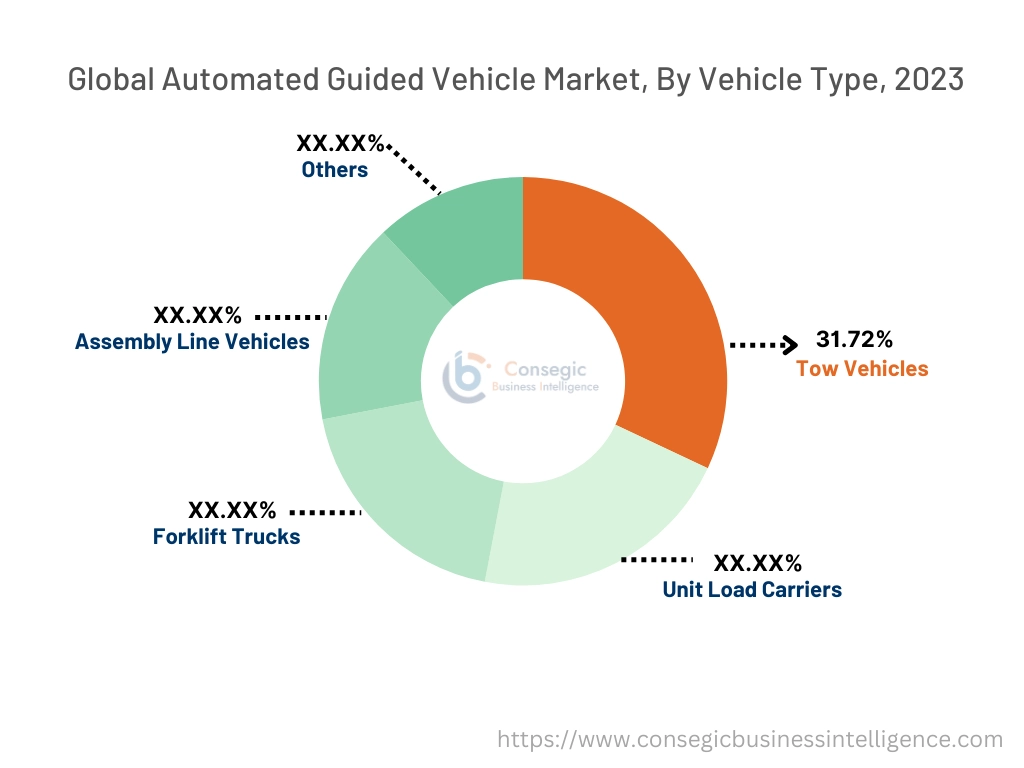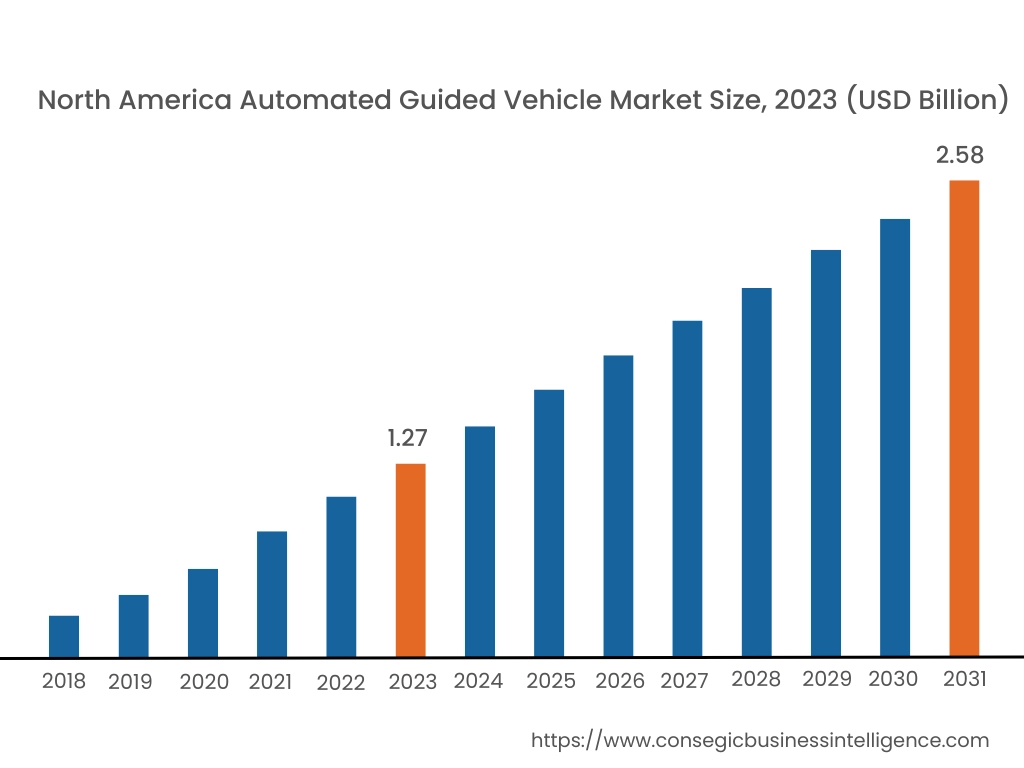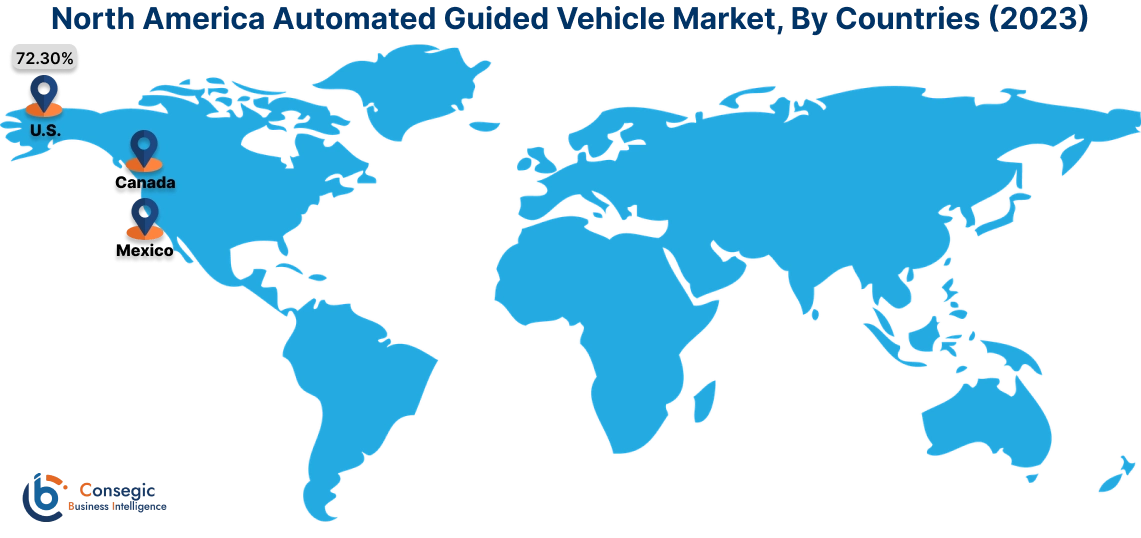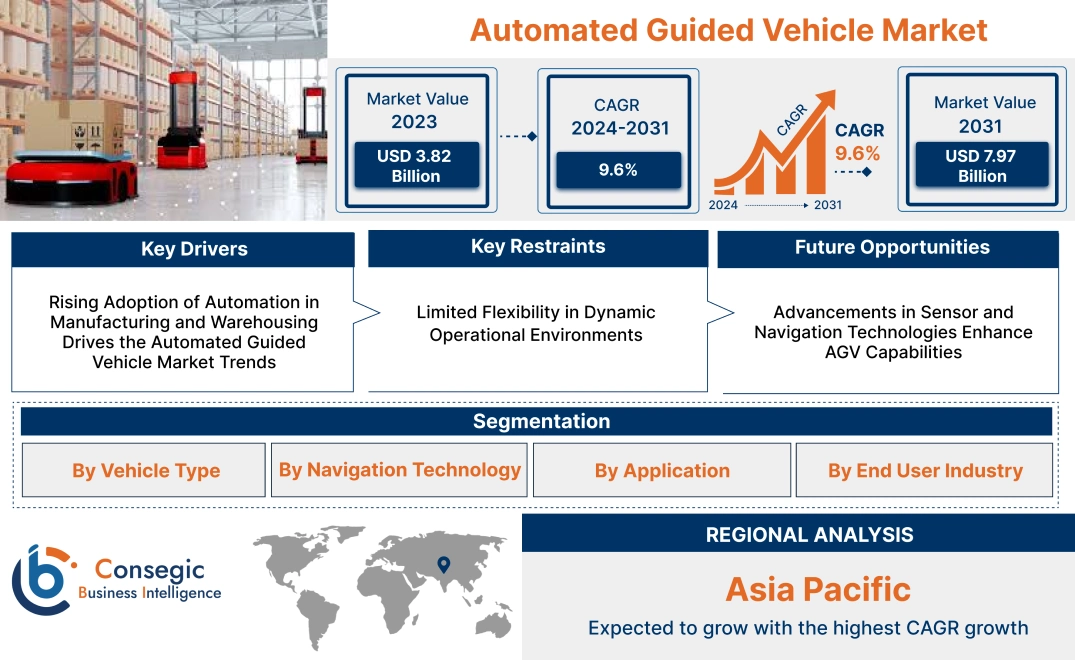Automated Guided Vehicle Market Size:
Automated Guided Vehicle Market size is growing with a CAGR of 9.6% during the forecast period (2025-2032), and the market is projected to be valued at USD 8.68 Billion by 2032 from USD 4.16 Billion in 2024. Additionally, the market value for 2025 is attributed to USD 4.55 Billion.
Automated Guided Vehicle Market Scope & Overview:
Automated guided vehicles (AGVs), also referred to autonomous guided vehicles, are mobile robots designed for material transport within industrial environments such as factories, warehouses, and distribution centers. Operating without onboard human drivers, these robotic vehicles navigate by following predetermined paths established through various technologies such as magnetic tape, laser guidance, and more advanced vision-based and natural navigation systems among others. Equipped with sophisticated safety features, these vehicles enhance operational efficiency, reduce labor costs by automating repetitive tasks, and significantly improve workplace safety by minimizing human error in material handling processes. They represent a fundamental component in material transportation, order picking, pallet handling, and assembly line automation among others.
How is AI Impacting the Automated Guided Vehicle Market?
AI is fundamentally transforming the automated guided vehicle market by empowering AGVs with unprecedented levels of intelligence and autonomy. AI-powered navigation systems, utilizing LiDAR and cameras, enable AGVs to dynamically plan optimal routes, avoid obstacles in real-time, and adapt to changing environments, moving beyond rigid, pre-programmed paths. This enhances efficiency, reduces collision risks, and boosts productivity in warehouses and factories. Furthermore, AI contributes to predictive maintenance by analyzing sensor data to anticipate and prevent breakdowns, extending AGV lifespan and minimizing downtime. Overall, AI is making AGVs smarter, safer, and more adaptable, driving their wider adoption across industries.
Automated Guided Vehicle Market Dynamics - (DRO) :
Key Drivers:
Rising Demand for Automation in Manufacturing and Warehousing to Drive Automated Guided Vehicle Market Growth.
Various sectors such as automotive, retail, and e-commerce, among others majorly rely on manufacturing and warehousing. Various sectors are increasingly focusing on the adoption of smart factories that create consistent requirements for intelligent, automated solutions to optimize complex operations. Automate guided vehicles precisely address this need by automating repetitive and labor-intensive material handling tasks, such as transporting raw materials, work-in-progress goods, and finished products. Such automation drastically improves efficiency, throughput, and accuracy.
- For instance, the U.S. Commerce Department's NIST MEP has awarded USD 1,000,000 to MEP Centers to develop projects addressing new manufacturing problems, focusing on themes such as Manufacturing 4.0, workforce services, supply chain management, and artificial intelligence application.
Thus, as per the analysis, the growing necessity for automation in several sectors is fueling significant market growth.
Key Restraints :
Limited Flexibility in Dynamic Operational Environments to Hinder Automated Guided Vehicle Market Expansion.
Limits of the flexibility of automated guided vehicle in the environments that present varied requirements serve as a significant impediment to market demand. Traditional autonomous robots are designed to follow predetermined, fixed paths which majorly rely on physical guides consisting of wires or magnetic tapes. In contrast, modern industrial settings, such as agile manufacturing floors or rapidly reconfiguring warehouses, frequently encounter dynamic obstacles, fluctuating layouts, and non-predictable movements. When faced with such changes, fixed-path vehicles do not work efficiently, require manual intervention, or necessitate costly infrastructure modifications. This compromise operational efficiency and increases downtime. This inherent lack of adaptability makes them less suitable for highly fluid environments, ultimately limiting the overall market expansion.
Future Opportunities :
Adoption of Advancements in Sensor and Navigation Technologies to Create Automated Guided Vehicle Market Opportunities.
Innovations such as high-resolution LiDAR, sophisticated vision systems, and the development of simultaneous localization and mapping (SLAM) capabilities, and AI integration is making AGVs smarter, more flexible, and capable of navigating complex environments. This technological leap enables them to navigate more precisely, dynamically avoid obstacles, operate safely in complex human-robot collaborative environments, and adapt to changing facility layouts without extensive infrastructure modifications. Consequently, these advancements broaden applicability of these vehicles to a wider range of sectors and tasks, creating avenues for the automated guided vehicle market trends.
- For instance, in 2025, Scott Technology launched NexBot, a next-generation autonomous guided vehicles featuring a modular design, offering scalable back-end modules, advanced natural feature/LiDAR-based navigation, and comprehensive safety features, all while promoting sustainable, electric operations.
Henceforth, the growing adoption of advanced technologies is creating lucrative automated guided vehicle market opportunities over the forecast period.
Automated Guided Vehicle Market Segmental Analysis :
By Vehicle Type:
Based on vehicle type, the market is categorized into tow vehicles, unit load carriers, forklift trucks, assembly line vehicles, and others.
Trends in Vehicle Type:
- Rising adoption of tow vehicles in e-commerce and logistics for automated pallet and container movement in fulfillment centers is growing trend.
- Continuous advancements in forklift truck by integrating vision-guided systems and AI integration for improved safety and precision in high-stacking applications.
The tow vehicles segment accounted for the largest revenue of 31.72% in automated guided vehicle market share in 2024.
- Tow vehicles represent a traditional vehicle type within the market. These vehicles are designed to automatically connect to and pull one or more non-powered carts or trailers rather than carrying loads directly.
- Characterized by high towing capacity, they efficiently move large volumes of materials over extended distances, offering versatility through customizable towed carts.
- Typically operating on fixed or semi-fixed routes, their applications span delivering components to assembly lines, moving work-in-progress, and transporting finished goods, reflecting their foundational role in many material handling workflows, particularly in vast facilities.
- Additionally, advancements in technology, such as integration with laser-guided systems, have enhanced the precision and versatility of tow vehicles.
- Thus, as per the automated guided vehicle market analysis, the tow vehicle segment is dominating the automated guided vehicle market demand.
The forklift trucks segment is anticipated to register the fastest CAGR during the forecast period.
- Forklift trucks are fully automated versions of conventional manned forklifts, equipped with forks to pick up, transport, and deposit palletized loads at varying heights, including racks.
- Offering vertical handling capabilities, they are versatile for tasks such as automated put-away and retrieval, truck loading, and stacking in warehouses.
- Their adoption is driven by the need to optimize storage space and reduce labor costs, creating new segment opportunities.
- Innovations in navigation technologies along with growing preference for electric forklift trucks are making them highly desirable in modern logistics and retail.
- For instance, in 2024, Hyster introduced the fully electric, lithium-ion powered J2.0-3.5XTLG series forklift trucks, capable of lifting up to 3.5 tonnes for diverse applications.
- Overall, owing to the aforementioned factors the segment is expected to grow significantly over the forecast period.

By Navigation Technology:
Based on navigation technology, the market is categorized into laser guidance, magnetic guidance, vision guidance, inductive guidance, and natural navigation.
Trends in Navigation Technology:
- Enhanced precision through improved laser scanning capabilities, enabling more accurate docking and positioning.
- Continuous advancement in SLAM algorithms and sensor fusion (LiDAR, cameras, IMUs) leading to more robust and reliable operation in unstructured environments.
The laser guidance segment accounted for the largest revenue share in 2024.
- Laser Guidance is a popular and precise navigation technology, where vehicles utilize a rotating laser scanner to detect strategically placed reflectors.
- By measuring the angle and distance to at least three reflectors, the vehicle accurately triangulates its real-time position.
- This method offers high accuracy, often within millimeters, and excellent flexibility for path reconfiguration as it avoids physical floor modifications.
- This navigation technology is widely adopted in warehouses, manufacturing plants, and distribution centers for diverse material handling tasks requiring high precision or adaptability to changing layouts.
- Thus, as per analysis, the laser guidance segment holds a dominating position in the overall automated guided vehicles market growth.
The natural navigation segment is anticipated to register the fastest CAGR during the forecast period.
- Natural Navigation, leveraging SLAM (Simultaneous Localization and Mapping), represents the most advanced and flexible autonomous guided vehicle guidance technology.
- These vehicles utilize sensors like LiDAR and cameras to dynamically map their environment and localize themselves in real-time, eliminating the need for physical infrastructure.
- This method offers maximum flexibility, dynamic obstacle avoidance, and real-time path optimization, making it suitable for highly dynamic warehouse environments where routes are frequently changed or unpredictable.
- Thus, the aforementioned factors are expected to propel the segment revenue in future years.
By Application:
Based on application, the market is categorized into logistics and warehousing, assembly, packaging, trailer loading and unloading, and raw material handling.
Trends in the Application:
- Integration of AGV fleets with Warehouse Management Systems (WMS) and Warehouse Execution Systems (WES) for real-time inventory optimization and intelligent task assignment.
- Shift towards autonomous guided vehicles enabling modular and high-precision assembly lines for mass customization and efficient variant production.
The logistics and warehousing segment accounted for the largest revenue share in 2024.
- Logistics and Warehousing encompasses the automated movement of goods throughout warehouses, distribution, and fulfillment centers.
- Automated guided vehicles in this segment are crucial for optimizing storage space, streamlining inventory management, and facilitating rapid order fulfillment, particularly vital for the booming e-commerce sector.
- Their applications range from transporting goods from receiving to storage, replenishing picking locations, and moving picked orders to shipping, to supporting automated storage and retrieval systems.
- The increasing automation demands in e-commerce, the need for efficient material handling systems, and wholesale distribution are the factors significantly driving the segment growth.
The packaging segment is anticipated to register the fastest CAGR during the forecast period.
- In packaging, AGVs play a crucial role by automating the efficient movement of various materials.
- They are deployed to transport packaging components, such as empty pallets, bottles, cans, labels, to production lines, and subsequently, to move finished, packaged products from these lines to staging, storage, or shipping areas.
- This automation focuses on ensuring the precise and timely delivery of materials, thereby preventing disruptions on fast-paced packaging lines.
- Furthermore, these vehicles minimize product damage during transport and facilitate a just-in-time supply of essential packaging components, streamlining the entire packaging workflow from raw materials to outbound goods.
- The packaging segmental analysis is anticipated to exhibit rapid growth, primarily driven by the prevailing trend of automating packaging operations to enhance efficiency and ensure compliance with sector-specific quality standards.
By End-Use:
Based on the end use, the market is categorized into automotive, aerospace & defence, food & beverage, healthcare, and others.
Trends in the End Use:
- The growing integration in electric vehicle manufacturing for efficient battery assembly and heavy component handling is a key trend.
- The preference on using autonomous guided vehicles to minimize human contact with sensitive or hazardous materials for improving hygiene and reducing the risk of disease transmission in healthcare facilities is growing.
The automotive segment accounted for the largest automated guided vehicle market share in 2024.
- This dominance of the automotive end use sector is due to the utilization of AGVs across the entire manufacturing spectrum, from initial inbound logistics to the final assembly line.
- In automotive, the vehicles are applied for transporting raw materials to production lines, efficiently moving vehicle chassis which generally include car bodies and engines between various assembly stations.
- They also play a crucial role in delivering just-in-time (JIT) parts directly to specific workstations and handling completed vehicles or sub-assemblies.
- This adoption is driven by the sector’s need for high-volume production, stringent requirements for precision and repeatability.
- For instance, according to the ACEA, the European Union produced 2.7 million commercial vehicles in 2023, marking a significant 20.3% increase compared to the production figures of 2022.
- Thus, as per the aforementioned factors, the automotive segment is dominating automated guided vehicle market demand.
The aerospace & defence segment is expected to grow at the fastest CAGR over the forecast period.
- The aerospace & defense sector utilizes automated guided vehicles for handling large, heavy, and high-value components during assembly, maintenance, and transportation within expansive facilities.
- The sector uses these guided vehicles for aircraft fuselages, wings, and engine components through production hangars, alongside transporting specialized tools.
- This adoption is driven by the critical need for extreme precision and safety when handling delicate and expensive parts.
- Consequently, based on the market analysis, this segment is projected to be one of the fastest-growing market, reflecting increasing automation investments for large-scale, complex manufacturing processes.
Regional Analysis:
The regional segment includes North America, Europe, Asia Pacific, the Middle East and Africa, and Latin America.

In 2024, North America accounted for the highest market share at 33.56% and was valued at USD 1.40 Billion and is expected to reach USD 2.75 Billion in 2032. In North America, the U.S. accounted for a market share of 70.12% during the base year of 2024.
The upwards trajectory of the region is primarily distinguished by robust demand from its e-commerce, automotive, and general manufacturing sectors, coupled with significant investment in automation. Particularly, the region's extensive e-commerce infrastructure necessitates highly automated warehouses and distribution centers for rapid order fulfillment. Furthermore, a strategic push towards reshoring and nearshoring manufacturing operations inherently requires increased automation to maintain global competitiveness. This is further amplified by North American companies' proactive stance in adopting cutting-edge automation and robotics solutions, making autonomous guided vehicles indispensable for material handling in its large automotive and aerospace sectors.
- For instance, according to NAIOP, shift in North American manufacturing driven by onshoring and nearshoring is creating significant demand for manufacturing and logistics space, with over 300 announced projects since 2020 totaling over USD 400 billion in investment, 210,000 new jobs, and 250 million square feet of new manufacturing space over the next decade.
Thus, as per analysis, these factors collectively position North America as a key region for the market.

In Asia Pacific, the Automated Guided Vehicle industry is experiencing the fastest growth with a CAGR of 12.2% over the forecast period owing the rapid industrialization and significant manufacturing growth underway in countries like China and India, which are driving the widespread adoption of automation to enhance production efficiency and scale. Additionally, the rise of online retail and booming e-commerce activities across the region necessitate advanced warehouse automation, making AGVs critical for efficient fulfillment and logistics centers. This shift is further supported by active government initiatives and substantial investments promoting smart manufacturing and Industry 4.0, all leveraging the region's vast manufacturing base in automotive, electronics, and food & beverage sectors. Collectively these factors fuel Asia Pacific automated guided vehicle market analysis.
European market is defined by the strong focus on advanced manufacturing and operational excellence. European nations emphasize implementing manufacturing 4.0 and smart factory concepts for interconnected and intelligent production lines. The continent's well-established manufacturing and automotive sectors are major consumers, leveraging this technology extensively for assembly, material handling, and logistics. This widespread adoption is also supported by a strong emphasis on worker safety and ergonomics coupled with continuous technological innovation in autonomous guided vehicles technologies. Hence, as per analysis, these factors collectively present a positive impact on the European market trends.
The automated guided vehicle market expansion in Latin America is rising with increasing awareness and adoption stemming from ongoing industrialization and a strong drive for efficiency improvements. This is significantly fueled by the growth in the manufacturing, automotive, and consumer goods sectors across the region. Moreover, an influx of foreign investment means international companies establishing production facilities often introduce advanced automation best practices. Concurrently, efforts to modernize logistics and warehousing operations are intensifying, aiming to enhance supply chain efficiency and reduce operational costs. thereby driving the upward automated guided vehicle market trend.
The market in Middle East and Africa is characterized by economic diversification and substantial infrastructure investments. Driven by Gulf Cooperation Council (GCC) countries channeling funds into non-oil sectors such as manufacturing and logistics, and the concurrent development of new, inherently automated industrial hubs and free zones, automated guided vehicles adoption is accelerating. An increasing focus on food security also fuels investments in automated agricultural processing and warehousing. Also, the UAE's digital transformation push, and Saudi Arabia's Vision 2030 are boosting their integration into logistics and industrial modernization.
Top Key Players & Market Share Insights:
The Global Automated Guided Vehicle Market is highly competitive with major players providing products to the national and international markets. Key players are adopting several strategies in research and development (R&D) and product innovation to hold a strong position in the global Automated Guided Vehicle market. Key players in the Automated Guided Vehicle industry include
- Daifuku Co., Ltd. (Japan)
- JBT (United States)
- KUKA AG (Germany)
- Hyster-Yale Materials Handling, Inc. (United States)
- Swisslog Holding AG (Switzerland)
- Toyota Industries Corporation (Japan)
- Seegrid Corporation (United States)
- Oceaneering International, Inc. (United States)
- E&K Automation GmbH (Germany)
- KION Group AG (Germany)
Recent Industry Developments:
- In 2025, Scott Technology unveiled NexBot, a next-generation automated guided vehicle. Designed to enhance automation accessibility, cost-effectiveness, and deployment ease, NexBot features a modular architecture that facilitates faster implementation without the lengthy lead times or high costs typically associated with autonomous guided vehicles
Automated Guided Vehicle Market Report Insights :
| Report Attributes | Report Details |
| Study Timeline | 2018-2031 |
| Market Size in 2031 | USD 8.68 Billion |
| CAGR (2024-2031) | 9.6% |
| By Vehicle Type |
|
| By Navigation Technology |
|
| By Application |
|
| By End Use |
|
| By Region |
|
| Key Players |
|
| North America | U.S. Canada Mexico |
| Europe | U.K. Germany France Spain Italy Russia Benelux Rest of Europe |
| APAC | China South Korea Japan India Australia ASEAN Rest of Asia-Pacific |
| Middle East and Africa | GCC Turkey South Africa Rest of MEA |
| LATAM | Brazil Argentina Chile Rest of LATAM |
| Report Coverage |
|
Key Questions Answered in the Report
How big is the Automated Guided Vehicle market? +
In 2024, the Automated Guided Vehicle market is USD 4.16 Billion.
Which is the fastest-growing region in the Automated Guided Vehicle market? +
Asia Pacific is the fastest-growing region in the Automated Guided Vehicle market.
What specific segmentation details are covered in the Automated Guided Vehicle market? +
By Vehicle Type, Navigation Technology, Application, and End Use segmentation details are covered in the Automated Guided Vehicle market.
Who are the major players in the Automated Guided Vehicle market? +
Daifuku Co., Ltd. (Japan), JBT (United States), Toyota Industries Corporation (Japan) are some of the major players in the market.
Which end-use industry is expected to grow the fastest? +
The retail sector is expected to grow rapidly, driven by the rise of e-commerce and the adoption of smart warehouse solutions for efficient order fulfillment.


